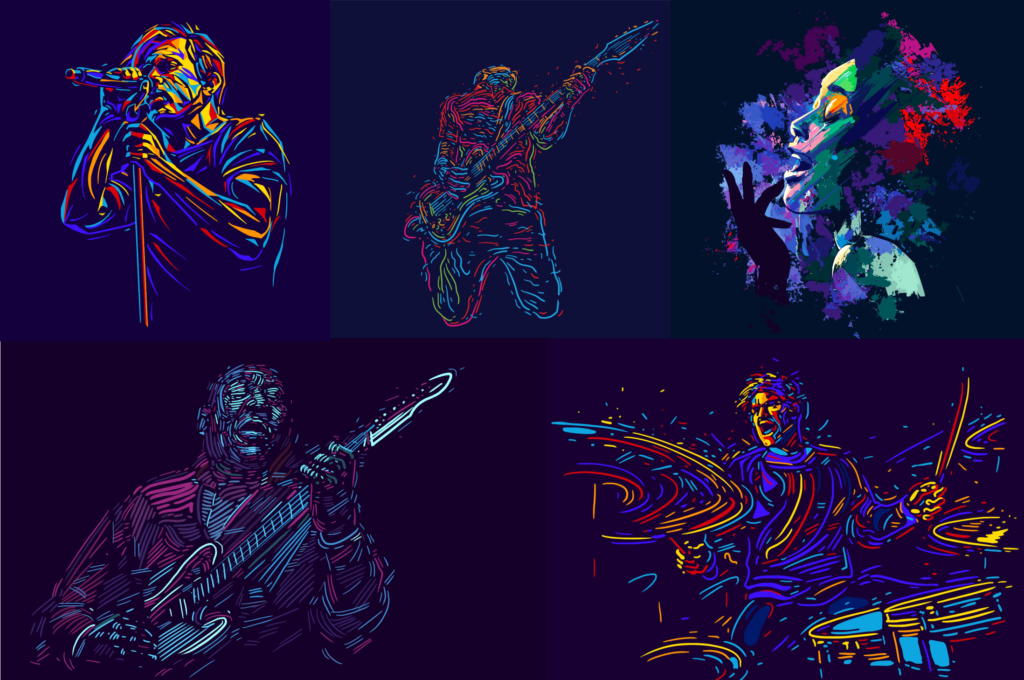
A couple weeks back, this blog explored the phenomenon I call the Mt. Rushmore of Classic Rock. It’s a way to visualize a rock fan’s all-time artists, using one of America’s most iconic national monuments as the backdrop.
But the other day on Facebook, WRIF night host Screamin’ Scott Randall posted a video that makes my Mt. Rushmore come alive, in a dynamic way that tells the story about music and radio in the latter half of the 20th century, right up until today.
A data visualization genius who uses the name Data Is Beautiful creates storytelling videos that let you draw your own conclusions about trends in music. I invite you to watch this amazing video that shows the popularity of music from 1969 until the present time by focusing on the top-selling artists and groups.
Moving quarter by quarter, we can see who was hot, whose success was sustainable, and who turned it to be a one-year wonder (think Psy). It’s a compelling way to visualize music trends in society, the rise and fall of popular artists and even broad genres, and how society and pop culture changed as a result.
It’s also a commentary on FM radio throughout the last half century because the story begins in 1969, when FM converters started showing up in cars, and radio would never be the same. You can see how broadcasting led and followed music trends, but always reflecting the mainstream of where music was coming – and going. The connection between radio and the music industry is inescapable.
Check out the video. It’s nearly 10 minutes long, but it goes by much faster than that.
Fascinating, mesmerizing, captivating. And as a programmer, I’ve always been especially interested in studying music trends. To a great degree, it’s what led to the development of the Classic Rock format. And the ultimate drought that has impactedRock music over the past couple decades.
This musical history lesson put together by Data Is Beautiful is entertaining to watch – and share. But it is also highly instructive. I’ve pulled out a series of chronological screen shots from the video that go a long way toward describing the changing music scene over time, along with some commentary that help explain the confluence of music and radio. Let’s go back to late 1970:
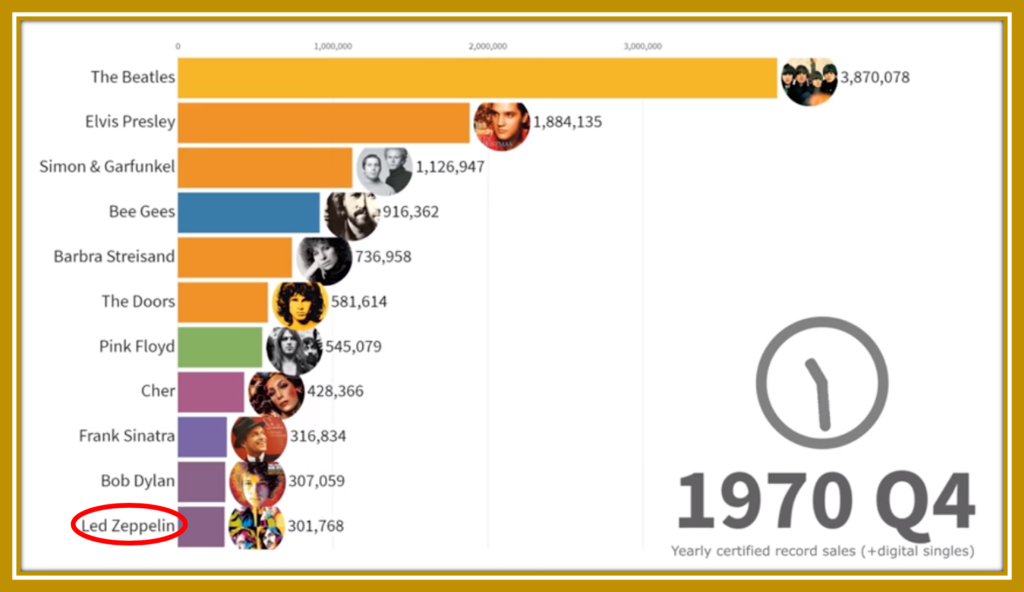
This is where we see the massive power of the Golden Age of Rock in the wake of the British Invasion. The Beatles dominated the year even as they were breaking up, but note how Elvis Presley remained very viable and highly commercial, and even Frank Sinatra continued to have impact.
But apart from the Pop scene – Cher, Streisand, and the pre-disco Bee Gees – FM rock radio was beginning to find its voice, thriving on the fast-rising popularity of artists like Dylan, Floyd, and the Doors. And note who’s bubbling under on this list – none other than Led Zeppelin who would go on to become one of the biggest forces in Rock N’ Roll.
Fast-forward six years to late 1976, and it’s a completely different world. Rock radio – or AOR, as it was called back then – was thriving, and you can see why when you look down this chart:
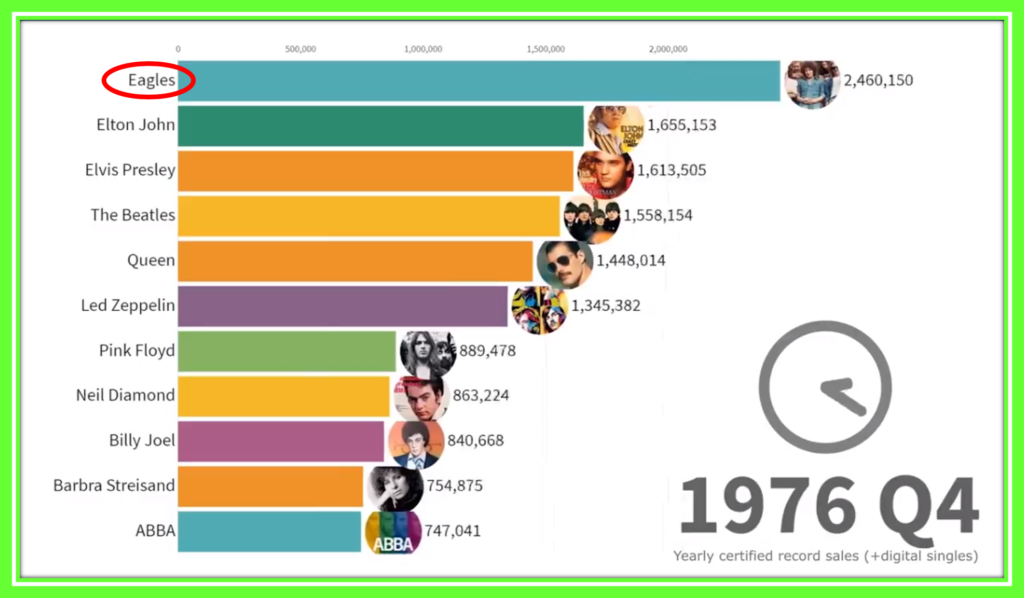
The Eagles are now firmly on top as their “Hotel California” album is released in this quarter. Elton John and Queen are emerging as major forces, and now Led Zeppelin is in the upper tier.
While the Beatles have lost steam, they continue to be a force – seven years after breaking up. And Elvis remains solid several months before his death. Pop music has some solid but non-dominating entrants in Neil Diamond, Streisand, and ABBA.
We move into the ’80s, and it’s a very different era in music. The screen shot below is from late 1983 – and we can see the effects of MTV and the music video genre.
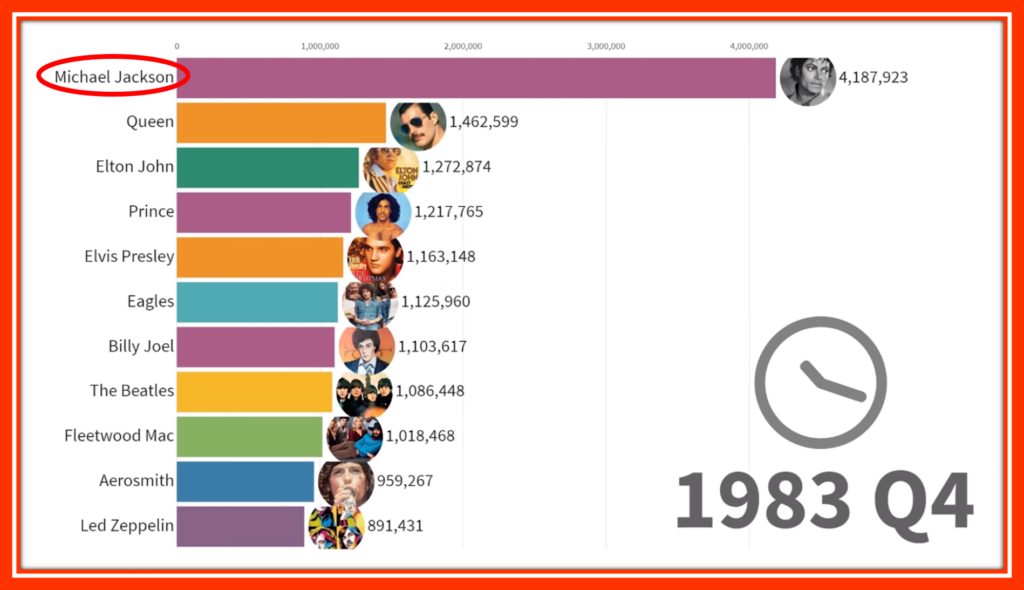
On the strength of his “Thriller” album (released the previous year, but still producing hit singles), Michael Jackson has now lapped the field. His sales totals more than double those of second place artist Queen.
The rest of the pack continues to support the Rock genre – with the exception of Prince and Elvis (!). Most of these other artists are “AOR” staples, keeping the radio format healthy with core artists that would go on to become the foundation of Classic Rock – yes, the Mt. Rushmore.
Just a couple of years later – the beginning of 1986 to be exact – and the chart is similar. Except for the emergence of Madonna:
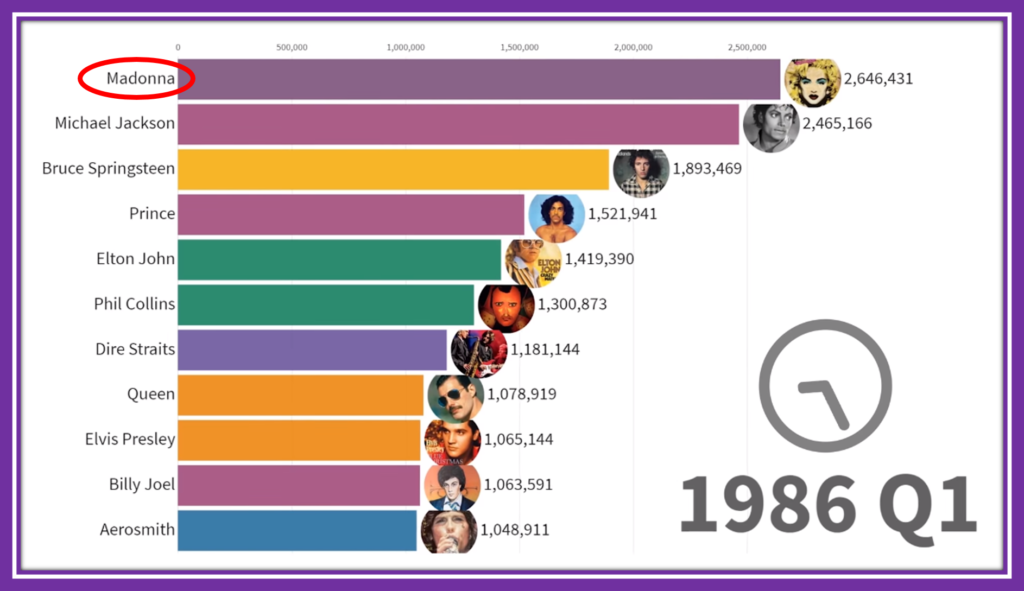 Michael Jackson is right there, too, and Prince is not far behind.
Michael Jackson is right there, too, and Prince is not far behind.
Note the presence of Bruce Springsteen who officially breaks through as a force. And while the Beatles are nowhere to be seen, Elvis still has significant presence.
And that takes us into the 90’s:
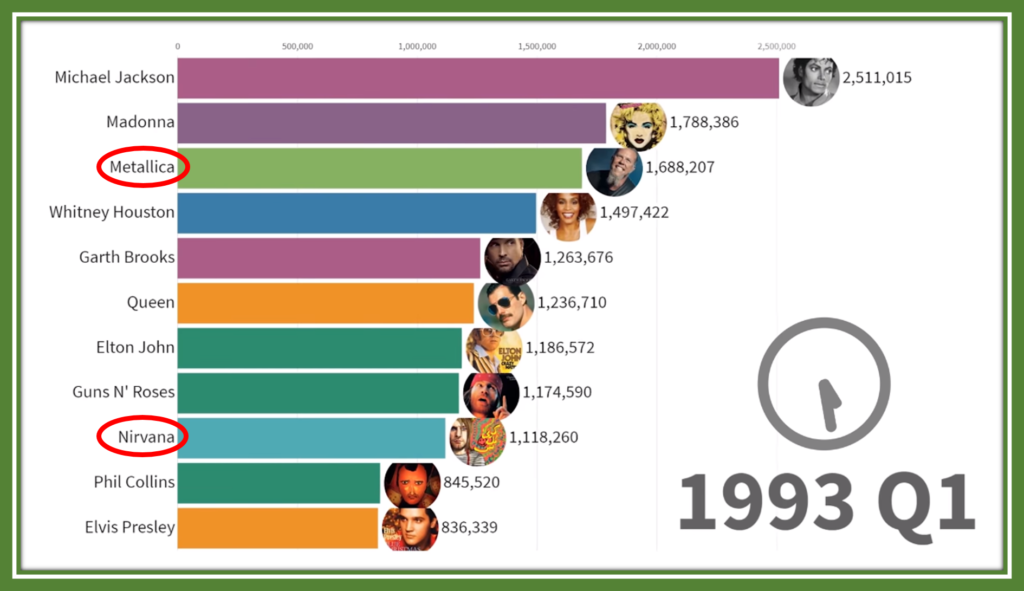 On the surface, it’s another year where Michael Jackson once again leads the league. And right along with him, Madonna looks solid, along with the presence of Whitney Houston, now in the top 5.
On the surface, it’s another year where Michael Jackson once again leads the league. And right along with him, Madonna looks solid, along with the presence of Whitney Houston, now in the top 5.
But there’s also the beginnings of a Rock resurgence with Metallica moving into the mainstream. And thanks to Nirvana’s entry, Grunge becomes its own music genre, and the word “Alternative” starts to appear all over the radio dial, replacing “Modern Rock.”
Let’s not overlook Garth Brooks, ushering in a new generation of Country, replacing the old guard – Kenny Rogers, Dolly Parton, and the rest.
Oh, and Elvis? Still hanging in.
As we segue into the late 90’s, Country is now emerging as a force. And that coincides with its dominance on the radio in market after market.

Garth is now joined by Shania Twain, and Pop and AC music are dominating the radio airwaves – Celine Dion, Mariah Carey, Whitney Houston (again), as well as Madonna and a fading Michael Jackson.
But sitting on top is a phenomenon that keeps repeating itself over the years – boy bands – specifically, the Backstreet Boys.
Metallica is in fast fade, and note the total absence of other rockers on the chart. Similarly, Alternative is back under the radar. And say goodbye to Elvis.
And at the bottom of this chart – but symbolically important for the coming explosion of Hip-Hop – there’s Eminem.
Five years into the new millennium, it’s a different world:
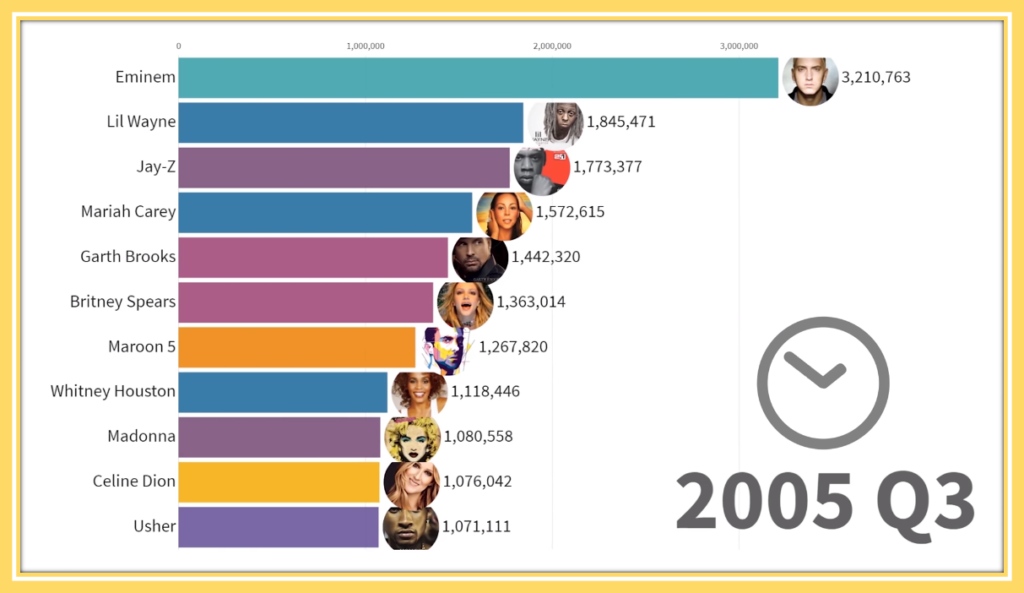 Eminem is now on top of the world, joined by rappers Lil Wayne and Jay-Z occupying the top 3 positions.
Eminem is now on top of the world, joined by rappers Lil Wayne and Jay-Z occupying the top 3 positions.
The rest of this chart is mostly comprised of mainstream Pop and Adult Contemporary acts.
And Rock? Nowhere to be seen.
Four years later, these trends are amplified:
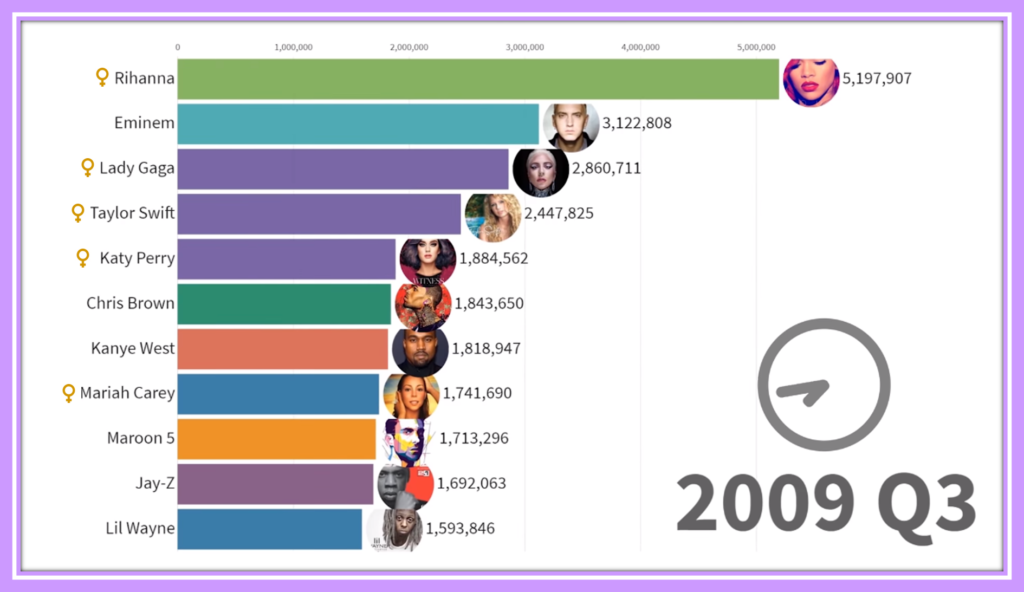
The music world is now completely dominated by Hip-Hop and female artists.
Current Rock and Alternative music are M.I.A., along with Country – with the exception of Taylor Swift, who would defect to Pop in 2014.
And that brings us up to today. In several of these snapshots over time, you can see defining trends and music styles. Looking at the music world a decade later here in 2019, we see Drake on top of a heap of mostly Pop artists:
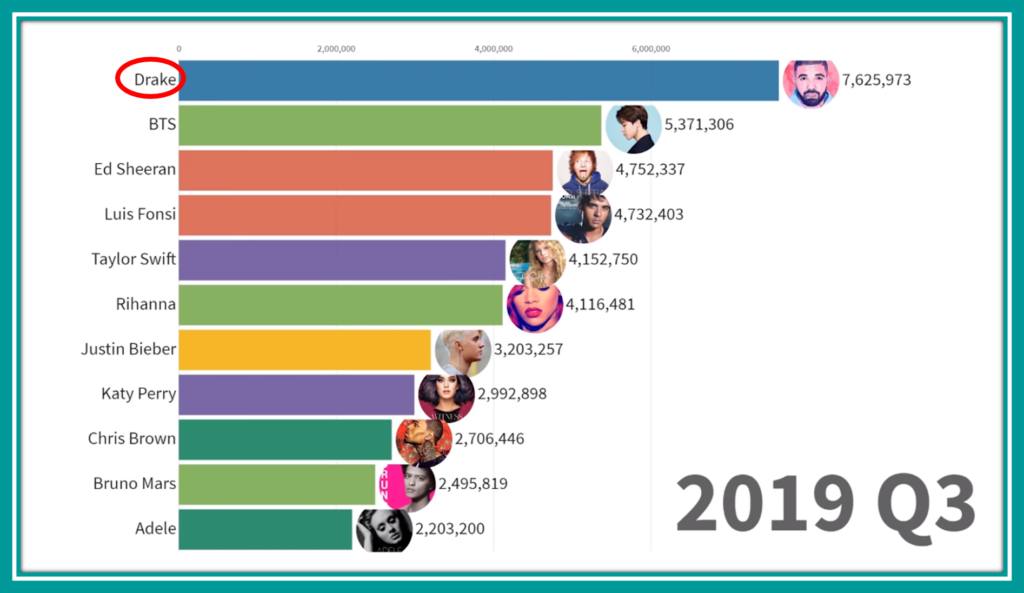
Aside from the emergence of Puerto Rican hero, Luis Fonzi, and this year’s boy band, BTS, all the other performers on this current list are “veterans,” from Adele to Katy Perry to Justin Bieber. And of course, Taylor Swift has made the leap to Pop-dom, as exemplified by her strong showing on this year’s list of top sellers.
Notably, Rock – which dominated the early versions of these charts a half century ago – is totally gone, as is Country. In fact, I rewound the video back to 2015 – not a single Rock or Country performer has made this chart in at least two years.
What this says about these radio formats is open to discussion and debate. I’m not knowledgeable enough to prognosticate about Country. But when it comes to Rock, it’s common knowledge that new, current-based so-called Active Rock stations don’t sign on very often these days. And while conventional wisdom suggests having a great morning show is a key to success, not having enough new music to play is a fundamental problem.
A lot has changed since Data Is Beautiful started charting music sales 50 years ago – in the country, in our culture, and with our  technology. The ways in which we discover music, listen to music, and create our own playlists and “mix tapes” have undergone incredible change.
technology. The ways in which we discover music, listen to music, and create our own playlists and “mix tapes” have undergone incredible change.
While we once purchased music – on vinyl, 8-tracks, cassettes, CDs, and digital downloads, the economics have shifted away from ownership and to a world where cloud-based music has become a commodity, making the album almost a thing of the past.
Data scientists like Data Is Beautiful are the new digital storytellers. I don’t know the name of the person who creates these videos, a first-year PhD student and a self described “data geek” who prefers to remain anonymous.
They visualization artists are increasingly finding new ways to use data to put our rapidly changing world into perspective.
Charting the new path of “radio & records” is something that all broadcasters and label heads should be paying attention to in order to ensure their respective relevance in the years to come.
The mathematician, John Tukey, left us with this quote:
“The greatest value of a picture is when it forces us to notice what we never expected to see.”
Thanks to Data Is Beautiful, we have an amazing view of the music so dear to many of us.
Thanks to Data Is Beautiful for this incredible piece of work. You can subscribe to the YouTube channel here. And the link to the video featured above is here.
- In Radio, You Just Never Know - April 17, 2025
- The Secret To Making A Great Podcast (And Great Radio) - April 16, 2025
- I Read The (Local) News Today, Oh Boy! - April 15, 2025




Fabulous data presentation.
Appreciate that, Brad. I may have gone down the rabbit hole a bit, but it’s a fun ride.
A very broad stroke that leaves me with more questions than revelations
Like who’s missing?